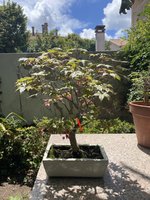Japanese maples are difficult enough to develop good mid and larger bonsai. Making good smaller bonsai is much, much harder.
All the current internodes on the tree are quite long suggesting it may be even harder to develop good small bonsai from this one.
Remember that after a trunk chop you need to allow for the new trunk, branches and apex to develop so the tree will almost certainly be quite a bit larger than the original chop because trees almost always grow up. As a rule of thumb, the first chop will be around 1/3 of finished bonsai height - if you are lucky but probably taller on a first try.
Small bonsai may sound easy and quick but they are actually quite a bit more tricky to do. Fitting branches and appropriate bends into a small trunk is challenging. Keeping a tree alive in a small container is also challenging. I tried and failed to keep smaller bonsai alive for quite a few years. After learning the techniques on mid and larger trees I finally managed to have better success with the smaller bonsai. Of course you may be a much better beginner grower than I was.



